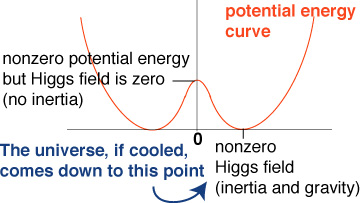
Higgs Fields
A Higgs field (named after a Scottish physicist Peter Higgs) is a field supposed to be responsible for the genesis of inertial mass (and, because of Einstein's equivalence principle, gravitational mass). When the universe is extremely hot, a Higgs field (which is supposed to have a certain curve of potential energy; as regards the shape of this curve, there is no unique consensus, except for a certain general feature, among the physicists) exerts a wild influence; but we will neglect this here. Once the universe cools down enough, below a certain temerature, the Higgs field assumes a certain value (i.e. a value of the Higgs field) which corresponds to the lowest energy level (i.e. the potential energy is zero, but the value of the Higgs field is nonzero; this level may be called vacuum). And this energy level continues to prevail throughout the whole universe (uniform, nonzero Higgs field).
Now, suppose a quark or electron moves (supposed fundamental particles which make up composite particles such as proton, neutron, or various atoms) in this uniform Higgs field. If that particle changes its velocity of movement, that is, if it accelerates, then the Higgs field is supposed to exert a certain amount of resistance or drag, and that is the origin of inertial mass. In a slightly more precise terminology, inertial mass is generated by interactions between a particle and the (nonzero) Higgs field. In a nutshell, this is the origin of inertial mass. Of course, other kinds of interaction, such as the strong interaction (governed by the force of gluons, particles gluing quarks together into a proton, say) may contribute significantly to the resulting mass. Moreover, the degree of resistance (drag) of the Higgs field is different depending on the kinds of fundamental particles, and this generates the difference between the mass of electron and that of a quark.
What if such a Higgs field did not exist? Many physicists believe that, then, all particles should be massless, like photon. Thus the difference between various particles may all disappear. Recent theories of unification suppose, in fact, that at the earliest stage of the universe, when the temperature was extremely high, that was indeed the case; and that, therefore, all differences between various particles disappeared and all forces were one. This is the essential part of the unification: i.e., at the beginning, all forces were one. Thus the formation of the nonzero Higgs field is (when the universe cools down) nothing but a phase transition of the universe: the transition which produces gravitational force (gravitational and inertial mass are the same). The manner of such a phase transition is schimatically illustrated in the following figure; imagine a ball, initially located at the top of the center hill rolls down the curve, and it will come to rest somewhere in the bottom. Also, the inflationary burst (the Higgs field is called inflaton field there) of the early universe is essentially related with this phrase transition, but we will discuss it in another page.
Leibniz, of course, never dreamt of Higgs fields; but his distinction between "active power" and "inertia" is somehow addressing to similar questions.
"The active power, which is in the form, and the inertia, or resistance to motion, which is in the matter". (Appendix A, 2, p. 89 of Ariew edition)
References
Greene, Brian (2004) The Fabric of the Cosmos, pp. 254-266, Allen Lane.
Guth, Alan (1997) The Inflationary Universe, pp. 137-145, 167-176, Perseus Books.
Last modified, April 28, 2005. (c) Soshichi Uchii
